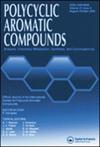新型5-芳基-3-(4-芳基-1,3-噻唑-2-基)-1,2-恶唑衍生物的合成及抗菌筛选
IF 2.6
3区 化学
Q2 CHEMISTRY, ORGANIC
引用次数: 0
摘要
以5-芳基-1,2-恶唑-3-碳硫酰胺7a-d和2-溴-1-芳基乙酮8-11为原料,合成了一系列新的5-芳基-3-(4-芳基-1,3-噻唑-2-基)-1,2-恶唑衍生物12-27。化合物12 ~ 27通过IR、NMR、质谱等方法进行了表征。对化合物12 ~ 27的体外抑菌活性进行了评价,测定了化合物对奇异假单胞菌、大肠杆菌、金黄色葡萄球菌、枯草芽孢杆菌、黑曲霉和白色念珠菌的抑菌活性。其中化合物12、14、16、17、18、20、21、22、23、24、26和27对mirabilis具有较好的活性。SAR结果表明,1,2-恶唑C-5位的3,4-二甲氧基对P. mirabilis的活性均较好,表明3,4-二甲氧基对活性起重要作用。化合物12 ~ 27对大肠杆菌、枯草芽孢杆菌、金黄色葡萄球菌、黑曲霉和白色念珠菌活性较低。活性衍生物在25和50µg/mL浓度下对小鼠胚胎成纤维细胞(3T3L1)的细胞毒性进行了评估,发现无细胞毒性。这些结果表明,1,3-噻唑的2位与1,2-恶唑的3位在广谱活性方面效果较差,需要进一步改进。本文章由计算机程序翻译,如有差异,请以英文原文为准。
Synthesis and Antimicrobial Screening of New 5-Aryl-3-(4-Aryl-1,3-Thiazol-2-yl)-1,2-Oxazole Derivatives
A new series of 5-aryl-3-(4-aryl-1,3-thiazol-2-yl)-1,2-oxazole derivatives 12–27 have been efficiently synthesized from 5-aryl-1,2-oxazole-3-carbothioamides 7a–d and 2-bromo-1-aryl ethanone 8–11. Compounds 12–27 were characterized by IR and NMR spectroscopy and mass spectrometry methods. Compounds 12–27 were evaluated for in vitro antimicrobial activity against P. mirabilis, E. coli, S. aureus, B. subtilis, A. niger and C. albicans strains. Amongst the sixteen derivatives, against the P. mirabilis, compounds 12, 14, 16, 17, 18, 20, 21, 22, 23, 24, 26, and 27 exhibited good activity. The SAR exposed that for the 3,4-dimethoxyphenyl group at the C-5 position of the 1,2-oxazole, all four derivatives 20–23 showed good activity against P. mirabilis, which indicates the 3,4-dimethoxyphenyl group is essential for activity. Against the microbial strains E. coli, B. subtilis, S. aureus, A. niger and C. albicans, compounds 12–27 were found less active. The active derivatives were evaluated for cytotoxicity against normal cell line of mouse embryonic fibroblast cells (3T3L1) at 25 and 50 µg/mL concentrations and found non-cytotoxic. These results suggested that the clubbing of the 2-position of the 1,3-thiazole with the 3-position of 1,2-oxazole is less effective for a broad spectrum of activity and needs further modifications.
求助全文
通过发布文献求助,成功后即可免费获取论文全文。
去求助
来源期刊

Polycyclic Aromatic Compounds
化学-有机化学
CiteScore
3.70
自引率
20.80%
发文量
412
审稿时长
3 months
期刊介绍:
The purpose of Polycyclic Aromatic Compounds is to provide an international and interdisciplinary forum for all aspects of research related to polycyclic aromatic compounds (PAC). Topics range from fundamental research in chemistry (including synthetic and theoretical chemistry) and physics (including astrophysics), as well as thermodynamics, spectroscopy, analytical methods, and biology to applied studies in environmental science, biochemistry, toxicology, and industry. Polycyclic Aromatic Compounds has an outstanding Editorial Board and offers a rapid and efficient peer review process, as well as a flexible open access policy.
 求助内容:
求助内容: 应助结果提醒方式:
应助结果提醒方式:


